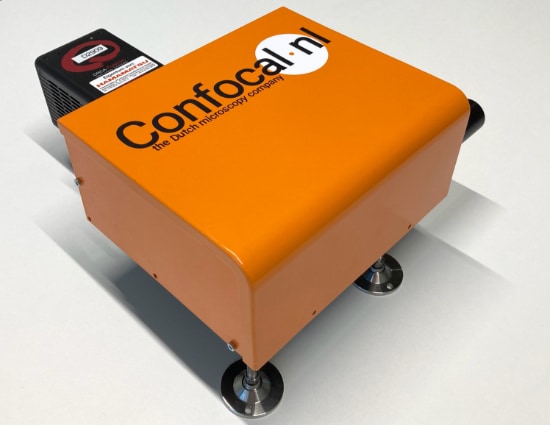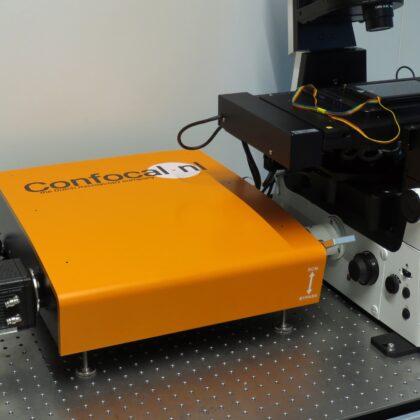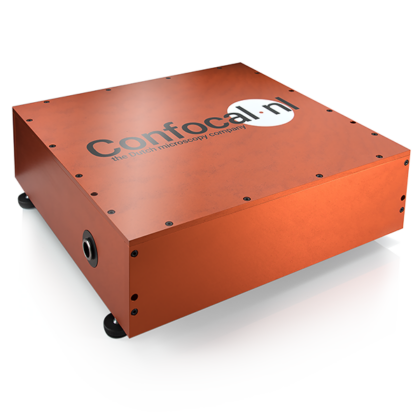What is NL5?
NL5 uses vintage technology from the eighties, now combined with modern cutting-edge digital technology, to create a fast confocal microscope with high resolution and perfect sensitivity. A slit pinhole, together with an extremely sensitive sCMOS camera as detector, make NL5 the perfect tool for fast and deep 3D live cell imaging.
Point-scanning confocal systems are commonly used, but their speed is limited. NL5 contains a slit pinhole that increases acquisition speed dramatically by scanning a full line at a time instead of a point. Due to the speed of the scanner, your samples will not be exposed to the laser for a long time, preventing photobleaching and phototoxicity. In addition, the high quantum efficiency of the modern sCMOS camera conjoined with NL5, allows for utilising low laser power. Therefore, a high signal-to-noise ratio image can be captured without signs of phototoxicity or bleaching.
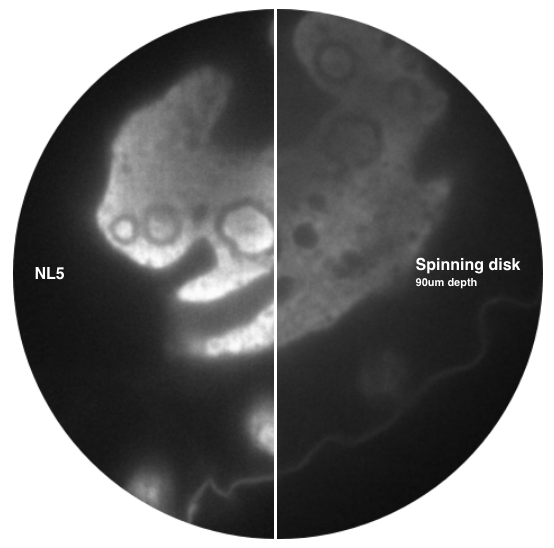
Contrary to spinning-disk systems, another advantage of NL5 and its slit pinhole is that it does not lead to pinhole crosstalk when imaging deep within the sample. NL5 reaches 240 nm lateral resolution which can be easily converted into 170 nm with on the fly deconvolution.NL5 is an excellent add-on to any research microscope. It allows for converting a wide-field system into a fast scanning confocal with high resolution and sensitivity.
How NL5 improves your imaging experience
- NL5 runs at a speed of 25 fps
- High contrast deep 3D imaging without pinhole cross-talk
- High sensitivity and resolution (170 nm after deconvolution)
- Live cell friendly
- Hardware integration into third-party software
- Compact & easy to use
If you would like to arrange a demo, please get in touch.
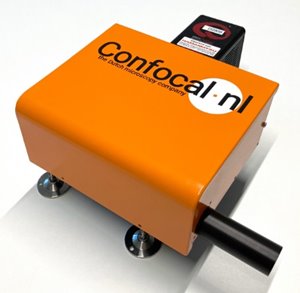
Fast scanning speed, low levels of phototoxicity
In the field of biology, some natural processes happen fast, like cell and protein dynamics and cell-cell interactions. Therefore, fast scanning speed is needed to study them. And that is exactly what NL5 brings to the table! In addition, researchers in developmental biology, regeneration or immunology fields often need to image large live samples (mouse embryos, zebrafish, organoids) for a long time without losing any detail of the cell’s behavior. In that case, a combination of speed and a low phototoxicity system like NL5 is perfect.
The benefits of using NL5
NL5 is a fast scanning confocal system that reaches 25 fps (full frame), much faster than regular point-scanning confocal systems. In addition to speed, it brings very gentle imaging conditions for your samples as well. Perform live cell imaging for more than a day, with no signs of phototoxicity. NL5 is easy to use, and requires basic training to operate.
NL5 does not cause any pinhole cross-talk, as it has only one slit pinhole. Pinhole cross-talk is associated with spinning disk systems, because they contain a disk with multiple pinholes combined and the out-of-focus light can sometimes pass through the closeby pinholes. This effect is more evident when imaging deep within the sample, making NL5 the ideal system for those applications.
NL5 is a cost-effective solution that can be coupled to any research microscope via the c-mount interface.
HeLa Cell with cytosolic GFP. Sample courtesy of Caroline Pham (Lodder’s Group). Experimental Cardiology Department. VUmc location AMC, Amsterdam
7 days old Arabidopsis thaliana root expressing nuclei targeted green calcium sensor
Sample courtesy of Dr Mayuri Sadoine and Prof Guido Grossmann, ICIB, Heinrich Heine University
Actin dynamics in A. thaliana root epidermis cells expressing LifeAct-mCitrin
Sample courtesy of Marjorie Guidchard, Milan Zupunski and Guido Grossmannfrom ICIB, University of Dusseldorf































